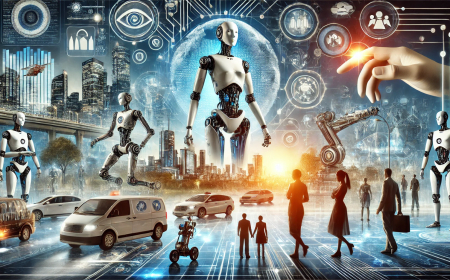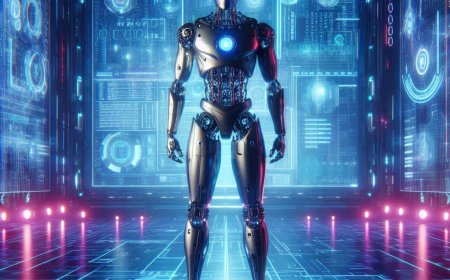Human-Robot Alliance: The Future of Collaborative Work
Discover how the alliance between humans and robots can reshape the future of work, increase productivity, and enhance the employee experience. Learn about the opportunities and challenges in this growing field.

Introduction: In a world characterized by rapid technological advancement, the alliance between humans and robots emerges as one of the most significant future trends that can radically reshape the nature of work. This alliance combines the unique human capabilities with the advanced technology of robots, providing immense opportunities to improve productivity, efficiency, and enhance the employee experience. In this article, we will detail the benefits and challenges of the human-robot alliance and explore how it can impact the future of work.
Defining the Human-Robot Alliance: The human-robot alliance refers to the close cooperation between humans and machines in the workplace to achieve common goals. This alliance aims to leverage the strengths of both humans and robots, with humans offering creative thinking and flexibility, while robots excel at performing repetitive and complex tasks with high precision.
History and Evolution of Robots in the Workplace: The use of robots in the workplace began in the mid-20th century, primarily in manufacturing industries for performing heavy and repetitive tasks. With technological advancements, robots have become smarter and more versatile, expanding their applications to various industries such as healthcare, logistics, and even hospitality.
Benefits of the Human-Robot Alliance:
Increased Productivity and Efficiency: Robots can work around the clock without interruption, significantly contributing to increased productivity and efficiency. They can also perform tasks faster and with higher accuracy than humans, reducing errors and enhancing product quality.
Improved Safety: Robots are ideal for performing dangerous tasks or those requiring significant physical effort, reducing the risk of accidents and injuries in the workplace. They can also operate in harsh or unsuitable environments for humans, such as high-temperature areas or confined spaces.
Enhanced Employee Experience: By taking on strenuous and repetitive tasks, robots allow humans to focus on more creative and strategic work, boosting employee satisfaction and improving their work experience. This can also lead to reduced stress and increased job satisfaction.
Robots and Artificial Intelligence: Artificial intelligence plays a significant role in enhancing the capabilities of robots, making them smarter and more responsive. Smart robots can analyze data, learn from their experiences, and make decisions based on available information, increasing their effectiveness and efficiency at work.
Challenges and How to Overcome Them: Despite the numerous benefits of the human-robot alliance, there are some challenges that must be addressed to achieve success. Among the most prominent challenges are the high initial implementation costs, the need for employee training to work with robots, and adapting to rapid technological changes. These challenges can be overcome through good planning and investment in continuous training and development.
Training and Retraining: To maximize the benefits of the human-robot alliance, it is essential to provide comprehensive training programs for employees. This includes training them to use robots and understand how to collaborate effectively with them. Retraining programs can also be offered to employees whose jobs are affected by technological changes.
Success Stories: Many companies have successfully implemented the human-robot alliance. For example, Amazon uses robots in its distribution centers to increase efficiency and reduce delivery times. In the healthcare sector, some hospitals use robots to perform surgeries with high precision.
Impact on the Job Market: The human-robot alliance can lead to significant changes in the job market. While it may result in the loss of some traditional jobs, it can create new job opportunities requiring high technical skills. It is essential for the workforce to prepare for these changes by acquiring the necessary skills to work in a shared environment with robots.
Ethics and Responsibilities: The use of robots in the workplace raises several ethical questions and responsibilities. Companies must ensure that robots are used ethically and responsibly, considering employee rights and adhering to safety standards. There should also be transparency in how data collected by robots is used.
Robotic Technology in Various Industries: Robots are used in many industries in different ways. In manufacturing, they can assemble products quickly and accurately. In healthcare, robots can perform precise surgeries and assist patients in recovery. In logistics, robots are used to optimize storage and shipping processes.
Integration with Other Systems: To achieve optimal performance, robots should be integrated with other systems in the workplace, such as point of sale systems, inventory management, and customer relationship management systems. This integration helps improve efficiency and streamline operations.
Cost and Return on Investment: Although the initial cost of implementing robots may be high, the return on investment can be significant in the long run. Companies can achieve cost savings, increased productivity, and improved product and service quality.
Future Developments in Robotics: Future expectations for the development of robots indicate significant advancements in their capabilities and intelligence. We may see the emergence of more advanced and intelligent robots capable of performing more complex tasks and working more integrally with humans.
Supporting Technologies: In addition to robots, other technologies contribute to enhancing the human-robot alliance, such as augmented reality, the Internet of Things, and big data analytics. These technologies help create a smarter and more efficient work environment.
Innovation in Robotics: Innovation plays a crucial role in developing more effective and intelligent robots. Through innovation, robots can be developed to learn and adapt to different environments, increasing their usefulness in the workplace.
Robots and Human Collaboration: Human-robot collaboration can achieve remarkable results if implemented correctly. Companies should encourage a culture of collaboration and communication between employees and robots, helping achieve common goals.
A Look into the Future: In the future, the human-robot alliance is expected to become more common and widespread across various industries. With continuous technological advancements, we may see more integrated and effective alliances between humans and robots, reshaping the future of work in ways we could not have imagined before.
Conclusion: In conclusion, the human-robot alliance represents a significant step towards improving the future of work. By leveraging advanced technology and unique human capabilities, new levels of productivity and efficiency can be achieved, and the overall employee experience can be enhanced. Despite the challenges, the potential benefits make this alliance worth investing in.
Frequently Asked Questions:
What is the human-robot alliance? The human-robot alliance refers to the close cooperation between humans and machines in the workplace to achieve common goals, where humans provide creative thinking and flexibility, while robots excel at performing repetitive and complex tasks with high precision.
How can the human-robot alliance improve productivity? Robots can work around the clock without interruption, significantly contributing to increased productivity and efficiency. They can also perform tasks faster and with higher accuracy than humans, reducing errors and enhancing product quality.
What are the main challenges in the human-robot alliance? The most prominent challenges are the high initial implementation costs, the need for employee training to work with robots, and adapting to rapid technological changes. These challenges can be overcome through good planning and investment in continuous training and development.
How can training help employees adapt to working with robots? Comprehensive training programs for employees include training them to use robots and understand how to collaborate effectively with them. Retraining programs can also be offered to employees whose jobs are affected by technological changes.
What are the environmental benefits of the human-robot alliance? The human-robot alliance helps reduce resource and energy consumption, as robots can work efficiently and reduce waste. This can support environmental sustainability and reduce the carbon footprint of companies.
What are the future expectations for the development of robots? Expectations indicate significant advancements in their capabilities and intelligence, which may lead to the emergence of more advanced robots capable of performing more complex tasks and working more integrally with humans. The human-robot alliance is expected to become more common and widespread across various industries.
What's Your Reaction?










































